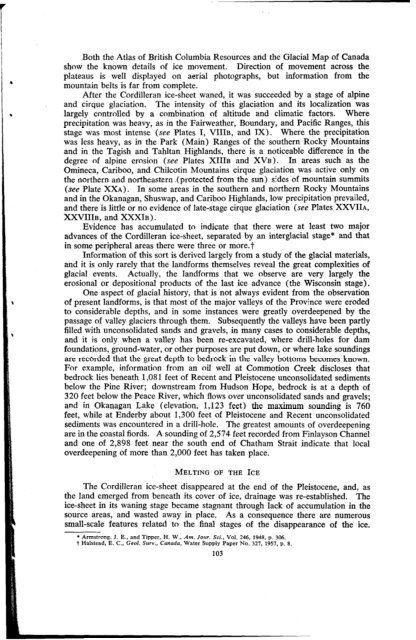Landforms of British Columbia 1976 - Department of Geography
Landforms of British Columbia 1976 - Department of Geography
Landforms of British Columbia 1976 - Department of Geography
You also want an ePaper? Increase the reach of your titles
YUMPU automatically turns print PDFs into web optimized ePapers that Google loves.
Both the Atlas <strong>of</strong> <strong>British</strong> <strong>Columbia</strong> Resources and the Glacial Map <strong>of</strong> Canada<br />
show the known details <strong>of</strong> ice movement. Direction <strong>of</strong> movement across the<br />
plateaus is well displayed on aerial photographs, but information from the<br />
mountain belts is far from complete.<br />
After the Cordilleran ice-sheet waned, it was succeeded by a stage <strong>of</strong> alpine<br />
and cirque glaciation. The intensity <strong>of</strong> this glaciation and its localization was<br />
largely controlled by a combination <strong>of</strong> altitude and climatic factors. Where<br />
precipitation was heavy, as in the Fairweather, Boundary, and Pacific Ranges, this<br />
stage was most intense (see Plates I, VIIIB, and IX). Where the precipitation<br />
was less heavy, as in the Park (Main) Ranges <strong>of</strong> the southern Rocky Mountains<br />
and in the Tagish and Tahltan Highlands, there is a noticeable difference in the<br />
degree <strong>of</strong> alpine erosion (see Plates XIIIB and XVB). In areas such as the<br />
Omineca, Cariboo, and Chilcotin Mountains cirque glaciation was active only on<br />
the northern and northeastern .(protected from the sun) sides ‘<strong>of</strong> mountain summits<br />
(see Plate XXA). In some areas in the southern and northern Rocky Mountains<br />
and in the Okanagan, Shuswap, and Cariboo Highlands, low precipitation prevailed,<br />
and there is little or no evidence <strong>of</strong> late-stage cirque glaciation (see Plates XXVIIA,<br />
XXVIIIB, and XXXIB) .<br />
Evidence has accumulated to indicate that there were at least two major<br />
advances <strong>of</strong> the Cordilleran ice-sheet, separated by an interglacial stage* and that<br />
in some peripheral areas there were three or more.?<br />
Information <strong>of</strong> this sort is derived largely from a study <strong>of</strong> the glacial materials,<br />
and it is only rarely that the landforms themselves reveal the great complexities <strong>of</strong><br />
glacial events. Actually, the landforms that we observe are very largely the<br />
erosional or depositional products <strong>of</strong> the last ice advance (the Wisconsin stage).<br />
One aspect <strong>of</strong> glacial history, that is not always evident from the observation<br />
<strong>of</strong> present landforms, is that most <strong>of</strong> the major valleys <strong>of</strong> the Province were eroded<br />
to considerable depths, and in some instances were greatly overdeepened by the<br />
passage <strong>of</strong> valley glaciers through them. Subsequently the valleys have been partly<br />
filled with unconsolidated sands and gravels, in many cases to considerable depths,<br />
and it is only when a valley has been re-excavated, where drill-holes for dam<br />
foundations, ground-water, or other purposes are put down, or where lake soundings<br />
are recorded that the great depth to bedrock in the valley bottoms becomes known.<br />
For example, information from an oil well at Commotion Creek discloses that<br />
bedrock lies beneath 1,08 1 feet <strong>of</strong> Recent and Pleistocene unconsolidated sediments<br />
below the Pine River; downstream from Hudson Hope, bedrock is at a depth <strong>of</strong><br />
320 feet below the Peace River, which flows over unconsolidated sands and gravels;<br />
and in Okanagan Lake (elevation, 1 ,123 feet) the maximum sounding is 760<br />
feet, while at Enderby about 1,300 feet <strong>of</strong> Pleistocene and Recent unconsolidated<br />
sediments was encountered in a drill-hole. The greatest amounts <strong>of</strong> overdeepening<br />
are in the coastal fiords. A sounding <strong>of</strong> 2,574 feet recorded from Finlayson Channel<br />
and one <strong>of</strong> 2,898 feet near the south end <strong>of</strong> Chatham Strait indicate that local<br />
overdeepening <strong>of</strong> more than 2,000 feet has taken place.<br />
MELTING OF THE ICE<br />
The Cordilleran ice-sheet disappeared at the end <strong>of</strong> the Pleistocene, and, as<br />
the land emerged from beneath its cover <strong>of</strong> ice, drainage was re-established. The<br />
ice-sheet in its waning stage became stagnant through lack <strong>of</strong> accumulation in the<br />
source areas, and wasted away in place. As a consequence there are numerous<br />
small-scale features related to the final stages <strong>of</strong> the disappearance <strong>of</strong> the ice.<br />
* Armstrong, J. E., and Tipper, H. W.; Am. Jour. Sci., Vol. 246, 1948, p. 306.<br />
t Halstead, E. C., Geol. Surv., Canada, Water Supply Paper No. 327, 1957, p. 8.<br />
103











